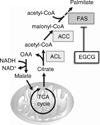Investigational cancer drugs targeting cell metabolism in clinical development
- PMID: 25224845
- PMCID: PMC4434605
- DOI: 10.1517/13543784.2015.960077
Investigational cancer drugs targeting cell metabolism in clinical development
Abstract
Introduction: Malignant cell transformation and tumor progression are associated with alterations in glycolysis, fatty acid synthesis, amino acid delivery and production of reactive oxygen species. With increased understanding of the role of metabolism in tumors, there has been interest in developing agents that target tumor specific metabolic pathways. Numerous promising agents targeting altered metabolic pathways are currently in Phase I - III clinical trials. Areas covered: This paper reviews the early phase clinical trial development of these agents and provides perspective on the future direction of this emerging field. Specifically, the authors describe novel and repurposed therapies, focusing on the effects of each agent on tumor metabolism and results from relevant Phase I and II clinical trials. Expert opinion: Metabolism modulating agents, alone and in combinations with other classes of agents, have shown efficacy in the treatment of neoplasm, which, the authors believe, will bear positive results in future studies. Because of the significant crosstalk between metabolic pathways and oncogenic signaling pathways, the authors also believe that combining metabolic modifiers with targeted agents will be an important strategy. An increased understanding of cancer metabolism, in addition to the continued study of metabolic modulators, should lead to further advances in this nascent therapeutic field in the future.
Keywords: Phase I and II; cancer; cell metabolism; drugs; metabolism modulating agents.
Figures





Similar articles
-
Targeting IL-6 for the treatment of rheumatoid arthritis: Phase II investigational drugs.Expert Opin Investig Drugs. 2014 Jul;23(7):979-99. doi: 10.1517/13543784.2014.912276. Epub 2014 Apr 26. Expert Opin Investig Drugs. 2014. PMID: 24766460 Review.
-
Emerging and investigational targeted chemotherapy and immunotherapy agents for metastatic brain tumors.Expert Opin Investig Drugs. 2020 Dec;29(12):1389-1406. doi: 10.1080/13543784.2020.1836154. Epub 2020 Oct 26. Expert Opin Investig Drugs. 2020. PMID: 33040640 Review.
-
The future of Cochrane Neonatal.Early Hum Dev. 2020 Nov;150:105191. doi: 10.1016/j.earlhumdev.2020.105191. Epub 2020 Sep 12. Early Hum Dev. 2020. PMID: 33036834
-
[Development of antituberculous drugs: current status and future prospects].Kekkaku. 2006 Dec;81(12):753-74. Kekkaku. 2006. PMID: 17240921 Review. Japanese.
-
Investigational drugs in Phase II clinical trials for the treatment of obesity: implications for future development of novel therapies.Expert Opin Investig Drugs. 2014 Aug;23(8):1055-66. doi: 10.1517/13543784.2014.918952. Epub 2014 Jul 7. Expert Opin Investig Drugs. 2014. PMID: 25000213 Review.
Cited by
-
Glucose Metabolism in Cancer: The Warburg Effect and Beyond.Adv Exp Med Biol. 2021;1311:3-15. doi: 10.1007/978-3-030-65768-0_1. Adv Exp Med Biol. 2021. PMID: 34014531 Free PMC article.
-
Reversal of the Warburg phenomenon in chemoprevention of prostate cancer by sulforaphane.Carcinogenesis. 2019 Dec 31;40(12):1545-1556. doi: 10.1093/carcin/bgz155. Carcinogenesis. 2019. PMID: 31555797 Free PMC article.
-
The ALDOA Metabolism Pathway as a Potential Target for Regulation of Prostate Cancer Proliferation.Onco Targets Ther. 2021 May 24;14:3353-3366. doi: 10.2147/OTT.S290284. eCollection 2021. Onco Targets Ther. 2021. PMID: 34079281 Free PMC article.
-
The pathobiology of polycystic kidney disease from a metabolic viewpoint.Nat Rev Nephrol. 2019 Dec;15(12):735-749. doi: 10.1038/s41581-019-0183-y. Epub 2019 Sep 5. Nat Rev Nephrol. 2019. PMID: 31488901 Review.
-
Ovarian Cancer Relies on Glucose Transporter 1 to Fuel Glycolysis and Growth: Anti-Tumor Activity of BAY-876.Cancers (Basel). 2018 Dec 31;11(1):33. doi: 10.3390/cancers11010033. Cancers (Basel). 2018. PMID: 30602670 Free PMC article.
References
-
-
Cairns RA, Harris IS, Mak TW. Regulation of cancer cell metabolism. Nat Rev Cancer. 2011;11(2):85–95. •• Excellent review of crosstalk between metabolic and oncogenic signaling.
-
-
-
Warburg O. On the origin of cancer cells. Science. 1956;123(3191):309–314. •• Original description of Warburg effect.
-
-
- DeBerardinis RJ, Lum JJ, Hatzivassiliou G, Thompson CB. The biology of cancer: metabolic reprogramming fuels cell growth and proliferation. Cell Metab. 2008;7(1):11–20. - PubMed
-
-
Macheda ML, Rogers S, Best JD. Molecular and cellular regulation of glucose transporter (GLUT) proteins in cancer. J Cell Physiol. 2005;202(3):654–662. • Good review of the role of glucose transporter family proteins in tumor metabolism.
-
Grants and funding
LinkOut - more resources
Full Text Sources
Other Literature Sources
